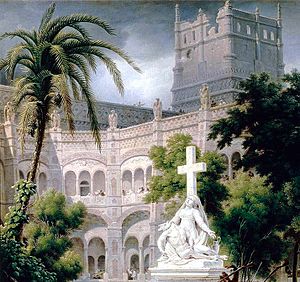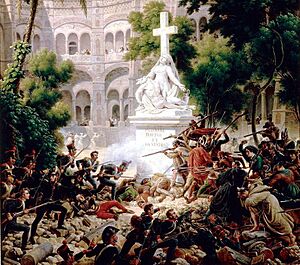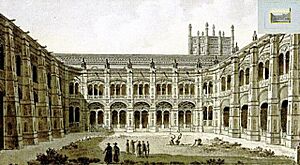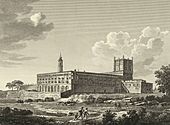Abbey of Santa Engracia facts for kids


The Abbey of Santa Engracia (Spanish: Real Monasterio de Santa Engracia) was a very old and important monastery in Zaragoza, Aragon, Spain. It was built to keep the relics (special items linked to saints) of Saint Engratia and other martyrs from Zaragoza. People believed it was founded around the year 392, connected to the travels of Saint Paulinus. The church was thought to be built exactly where Saint Engratia was martyred (killed for her beliefs).
Today, only the crypt (an underground room) and a part of its front wall remain. These parts are kept safe in the Church of Santa Engracia de Zaragoza. The rest of the monastery was destroyed during the sieges (long attacks) on Zaragoza by Napoleon Bonaparte's army. These attacks happened during the Peninsular War in 1808 and 1809. Even though the upper cloister (a covered walkway) survived the attacks, it was later taken down in 1836. The monastery was famous for its beautiful Isabelline and Renaissance buildings.
Contents
History of the Abbey
After the "Peace of Constantine," which allowed Christians to practice their faith freely, a large church was built. It stood over the tomb in the cemetery where the martyrs were buried. Some people believe that Saint Paulinus started the abbey during his visit to Zaragoza in 392.
Early Years and Growth
The monks living there might have first followed the Rule of St. Augustine. Later, they adopted the Benedictine Rule, which is a set of rules for monks to live by. The monastery became very important in the 7th century. Two famous church leaders, Eugenius II of Toledo and John of Zaragoza, came from this abbey. Braulio of Zaragoza, who was John's brother, also supported and protected the abbey. The monks continued to live and work there even when Muslims ruled the area.
Changes and Discoveries
In 1063, during the Synod of Jaca (1063) (a church meeting), the Bishop of Zaragoza gave the monastery to the bishopric of Huesca. This decision was confirmed again by Pope Gregory VII in 1121. Because it became a diocesan (church district) building, its leader was called a prior for 400 years, and then an archdeacon.
In 1389, workers digging at the site found the bodies of Saint Engratia and Lupercus. Their bodies were in two niches (small hollows in a wall) within a stone mound. Their names were carved on the stone. It's thought that Mozarabs (Christians living under Muslim rule) might have re-buried them there.
Royal Support and Restoration
People's devotion to Saint Engratia grew even more after this discovery. King John II of Aragon, also known as "the Great," was very grateful to the saint. He believed that a miraculous nail from her martyrdom had helped him recover from his cataracts (a problem with eyesight). Because of this, he asked his son, Ferdinand II of Aragon, to restore the monastery. Ferdinand then founded a monastery for Hieronymite monks there. In 1493, on Saint Engratia's day, the monks moved in. King Ferdinand and Queen Isabella attended the church services.
Around 1755, the building was restored again by an architect named Juan Morlanes. The money for this work came from Don Clemente Sánchez de Orellana y Riofrío. He was from Quito and paid 2,500 ducats (an old type of money) for the work. This payment was part of a deal for him to receive special titles.
Destruction of the Abbey
Over time, many parts of the old Gothic building were updated. However, both the old and new parts were destroyed on the night of August 14, 1808. This happened because of terrible explosions that shook Zaragoza when Napoleon's army began a second siege.
Abbey Architecture
One of the most famous parts of this church was its altarpiece (a decorated screen behind the altar). It also had the chapel of Antonio Agustín, who was a very important official in Aragon. His son, also named Antonio Agustín, became an Archbishop. The altarpiece was made with great care by the famous artist Berruguete. Next to the Agustín family tomb was the tomb of the famous writer Jerónimo de Zurita. His epitaph (words on a tombstone) read:
-
- HlERONlMO ZURITAE MlCHAELlS F. GABRIELIS N. CE-
- SAR -AUGUSTANO HISTORIAE ARAGONAE DILIGEN-
- TÍSIMO AC ELECTO SCRIPTORI. PATRI B. M.
- HIERONIMUS F. POSSUIT. VISIT ANNOS
- LXVII. MENSIS XI OBIIT CESARAUGSTAE III NON. NOVEMB. MDLXX.
The cloister (a covered walkway, usually around a courtyard) had a grand gallery. It featured large marble columns and beautiful sculptures and paintings by skilled artists. The tomb of Jerónimo de Blancas, another important writer from Aragon, was also located here. He passed away on December 11, 1590. The main altarpiece and other paintings in the church were done by Francisco Bayeu. After the destruction, all that remained was the famous front wall made of marble and alabaster. Its Plateresque style (a detailed Spanish Renaissance style) seems to have been the work of Diego Morlanes, who was the son of Juan Morlanes, the original sculptor.
Gallery
See also
 In Spanish: Monasterio de Santa Engracia (Zaragoza) para niños
In Spanish: Monasterio de Santa Engracia (Zaragoza) para niños
- Church of Santa Engracia de Zaragoza
- List of missing landmarks in Spain




